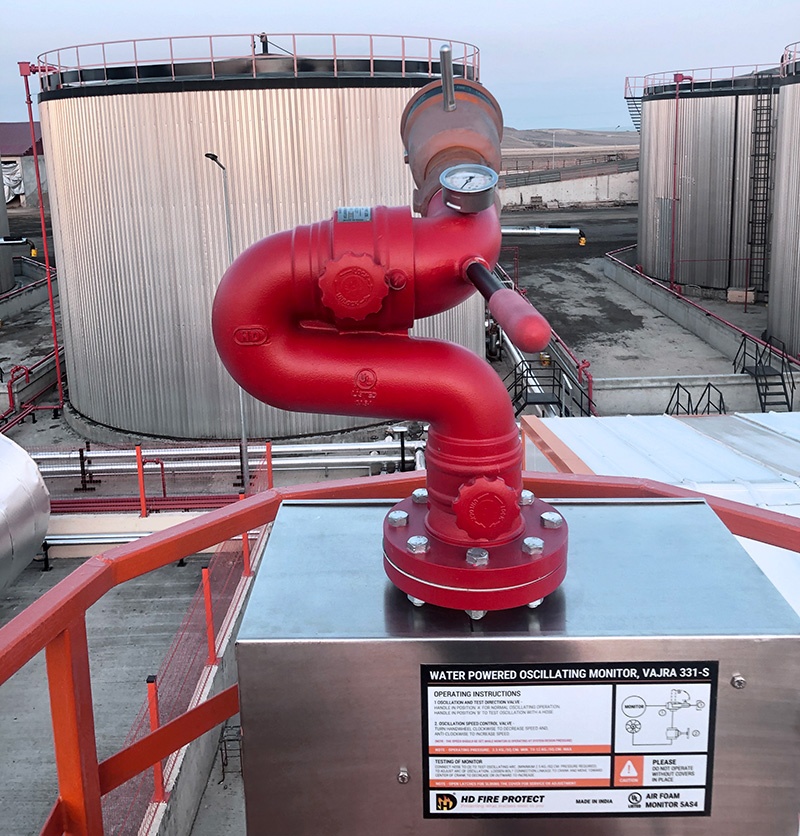Oil & Gas – effective protection methods
The oil and gas industry is one of the most risky working environments, where even the smallest mistake or unforeseen situation can lead to serious consequences. High temperatures, flammable substances and intensively used equipment make the need for effective fire protection solutions a priority. Oil & Gas gas extinguishing and foam technologies play a fundamental role in minimizing the risk of fires in this sector. In this article, we will explain how these systems work, what their advantages are and when they are best used.
How do gas extinguishing systems work in the Oil & Gas industry and why are they so effective?
Gas extinguishing systems are one of the most advanced technologies used in fire protection in the oil and gas industry. Their main principle of operation is the use of inert gases or chemicals that effectively eliminate fire by reducing oxygen or interrupting chemical reactions accompanying combustion.
Gas fire protection systems, such as those using carbon dioxide (CO2), FM-200 or Novec 1230, are indispensable in protecting critical equipment such as generators, turbines or control rooms. The high effectiveness of these systems results from their ability to act quickly without damaging infrastructure or interrupting the continuity of technological processes.
W przypadku projektowania instalacji przeciwpożarowych, w tym gazowych, istotne jest uwzględnienie specyfiki obiektu i potencjalnych zagrożeń. Profesjonalne projektowanie instalacji przeciwpożarowych pozwala dostosować system do wymagań przemysłu Oil & Gas, zapewniając skuteczność i niezawodność w krytycznych sytuacjach.When designing fire protection systems, including gas systems, it is important to take into account the specifics of the facility and potential threats. Professional design of fire protection systems allows you to adapt the system to the requirements of the Oil & Gas industry, ensuring effectiveness and reliability in critical situations.

When is it worth using foam extinguishing in the oil and gas industry?
Foam extinguishing industry is a technology that is particularly effective in the case of fires involving flammable liquids such as crude oil, gasoline, and chemicals. Extinguishing foam works by isolating the fire from oxygen, creating a protective barrier on the surface of flammable substances.
Its effectiveness in the case of flammable liquids makes it irreplaceable in limiting the access of air, which allows for quick and effective extinguishing of fires. This technology is also extremely useful in protecting large areas, such as refineries or storage terminals, where large quantities of flammable substances are stored. Thanks to the possibility of adjusting the type of foam – high percentage or low percentage – these systems can be precisely tailored to the specific threat. In the Oil & Gas industry, Oil & Gas foam systems minimize the risk of fire spreading, which is why they are a fundamental element of fire protection in such environments.
Properly designed and installed foam systems often complement sprinkler systems to provide comprehensive protection in high-risk environments such as manufacturing plants, warehouses, and terminals. Their combination increases the effectiveness of firefighting operations.
What gases are most commonly used in gas extinguishing systems in the Oil & Gas industry?
The choice of gas in extinguishing systems depends on the specifics of the protected object and the type of potential threat. The most commonly used gases include:
- [u]Carbon dioxide (CO2)[/u] – ideal for protecting electrical and mechanical equipment. Quickly reduces oxygen concentration, extinguishing fire without damaging equipment;
- [u]FM-200[/u] – a chemical gas that works by interrupting the combustion reaction. It is safe for devices and disperses quickly;
- [u]Novec 1230 [/u]– a modern extinguishing agent with low environmental impact, ideal for use in closed rooms.
These technologies provide effective protection against various types of fires while ensuring that infrastructure remains intact.
In the oil and gas industry, the choice of effective fire protection technologies is of strategic importance. Both gas vs. foam extinguishing and their combination in integrated systems allow for effective protection of people, property and the environment. Modern solutions, such as fire safety Oil & Gas, are both an industry standard and a necessity that helps minimize the risk of catastrophic consequences of fires. Regardless of the technology chosen, the priority is to ensure safety and compliance with the latest standards, which guarantees effectiveness and reliability in every situation.
